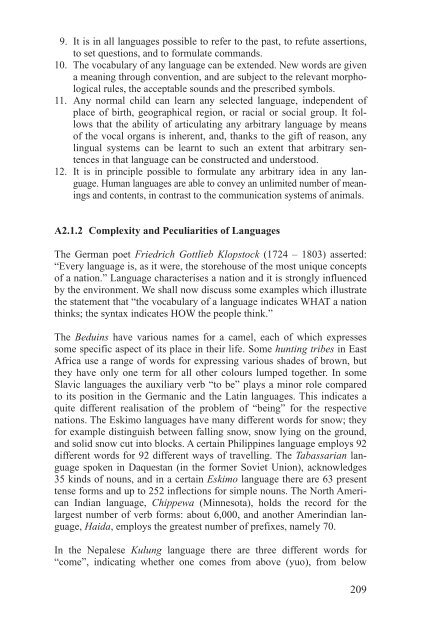In the Beginning was Information
6KezkB
6KezkB
- No tags were found...
You also want an ePaper? Increase the reach of your titles
YUMPU automatically turns print PDFs into web optimized ePapers that Google loves.
9. It is in all languages possible to refer to <strong>the</strong> past, to refute assertions,to set questions, and to formulate commands.10. The vocabulary of any language can be extended. New words are givena meaning through convention, and are subject to <strong>the</strong> relevant morphologicalrules, <strong>the</strong> acceptable sounds and <strong>the</strong> prescribed symbols.11. Any normal child can learn any selected language, independent ofplace of birth, geographical region, or racial or social group. It followsthat <strong>the</strong> ability of articulating any arbitrary language by meansof <strong>the</strong> vocal organs is inherent, and, thanks to <strong>the</strong> gift of reason, anylingual systems can be learnt to such an extent that arbitrary sentencesin that language can be constructed and understood.12. It is in principle possible to formulate any arbitrary idea in any language.Human languages are able to convey an unlimited number of meaningsand contents, in contrast to <strong>the</strong> communication systems of animals.A2.1.2 Complexity and Peculiarities of LanguagesThe German poet Friedrich Gottlieb Klopstock (1724 – 1803) asserted:“Every language is, as it were, <strong>the</strong> storehouse of <strong>the</strong> most unique conceptsof a nation.” Language characterises a nation and it is strongly influencedby <strong>the</strong> environment. We shall now discuss some examples which illustrate<strong>the</strong> statement that “<strong>the</strong> vocabulary of a language indicates WHAT a nationthinks; <strong>the</strong> syntax indicates HOW <strong>the</strong> people think.”The Beduins have various names for a camel, each of which expressessome specific aspect of its place in <strong>the</strong>ir life. Some hunting tribes in EastAfrica use a range of words for expressing various shades of brown, but<strong>the</strong>y have only one term for all o<strong>the</strong>r colours lumped toge<strong>the</strong>r. <strong>In</strong> someSlavic languages <strong>the</strong> auxiliary verb “to be” plays a minor role comparedto its position in <strong>the</strong> Germanic and <strong>the</strong> Latin languages. This indicates aquite different realisation of <strong>the</strong> problem of “being” for <strong>the</strong> respectivenations. The Eskimo languages have many different words for snow; <strong>the</strong>yfor example distinguish between falling snow, snow lying on <strong>the</strong> ground,and solid snow cut into blocks. A certain Philippines language employs 92different words for 92 different ways of travelling. The Tabassarian languagespoken in Daquestan (in <strong>the</strong> former Soviet Union), acknowledges35 kinds of nouns, and in a certain Eskimo language <strong>the</strong>re are 63 presenttense forms and up to 252 inflections for simple nouns. The North American<strong>In</strong>dian language, Chippewa (Minnesota), holds <strong>the</strong> record for <strong>the</strong>largest number of verb forms: about 6,000, and ano<strong>the</strong>r Amerindian language,Haida, employs <strong>the</strong> greatest number of prefixes, namely 70.<strong>In</strong> <strong>the</strong> Nepalese Kulung language <strong>the</strong>re are three different words for“come”, indicating whe<strong>the</strong>r one comes from above (yuo), from below209











![[Pham_Sherisse]_Frommer's_Southeast_Asia(Book4You)](https://img.yumpu.com/38206466/1/166x260/pham-sherisse-frommers-southeast-asiabook4you.jpg?quality=85)




